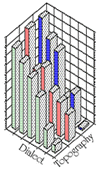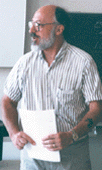 |
 |
Excerpt (with minor revisions) from J.K. Chambers, "An introduction to Dialect Topography," English World-Wide 15 (1994): 35-53. The DIALECT TOPOGRAPHY project is supported by a grant from the Social Sciences and Humanities Research Council.
Dialect Topography is the name given to a set of methods for surveying dialect variants in a region. These methods are being developed and applied now in the part of Canada known as the Golden Horseshoe: the western tip of Lake Ontario from Oshawa to Niagara Falls, including the conurbations of Scarborough, Toronto, Mississauga, Oakville, Burlington, Hamilton, St. Catharines and Welland (see Map 1). Over five million people, more than one-sixth of Canada's population, live in this 250km strip.
...It is my hope that future projects, with the DIALECT TOPOGRAPHY OF THE GOLDEN HORSESHOE as prototype, could concurrently produce regional dialect atlases from start to finish within three years.
1. Dialect Topography and Dialect Geography
As the name implies, Dialect Topography is intended as an alternative to Dialect Geography. Like Dialect Geography, it provides comparative linguistic data from individuals in a particular geographical setting.
It shares the basic goals of Dialect Geography. Both provide a macro-level perspective on linguistic variation. Both survey people in a continuous area, making it possible to identify and isolate gross linguistic differences among speakers from region to region. They can also provide the basis for charting linguistic change in subsequent surveys.
In two crucial respects, Dialect Topography differs from Dialect Geography, and is indeed a reaction to it: these are (1) representativeness, and (2) time-effectiveness.
1.1. Representativeness. One of the venerable criticisms of Dialect Geography is its use of non-representative samples. Pickford (1956: 217-18), in her classic critique, says: "The surveys of linguistic geography distort the picture of [regional] speech by selecting communities, informants, and data which magnify the degree--and thus the importance--of regional variations." This is true, of course, and has never been denied by dialect geographers. Non-representativeness is deliberate: dialect geographers are not interested in speech representative of society in general but in the speech of the most conservative speakers, especially NORMs, non-mobile, older, rural, predominantly males (Chambers & Trudgill 1980: 33). As McDavid (1981: 71) says, "Whether this is interesting or worthy of investigation is a matter of taste and purpose."
...Instead, we are interested in a representative sample with both sexes and all ages, classes, and other social factors. Unlike Dialect Geography, Dialect Topography is sociolinguistic, because its variants are correlated with independent variables such as age, sex, and ethnic background.
One consequence of using a representative sample is that a much larger population must be surveyed. Another is that, as Pickford implies in the quotation above, the number and extent of regional variations will be less dramatically represented--or, in her terms, less distorted.
The results of a Dialect Topography survey, though they may be less dramatic than a survey of NORMs, are interesting in their own right, and of course they should be interesting to more people simply because they are representative. They are, for the same reason, useful to teachers, lexicographers, actors, ESL instructors, and others who have an interest in knowing what the regional norms really are.
With a representative sample, the survey can also be useful in delimiting places where micro-level sociolinguistic studies might profitably be pursued. The use of the term 'topography', in the sense of a description of surface features (as it is used in geography and mathematics), purposely emphasizes the macro-level function.
1.2. Time-effectiveness. Another venerable criticism of Dialect Geography is the extraordinarily long time from the inception of a project to its completion....
The protracted production time is especially harmful if the project is to serve its purpose in attracting fine-grained researches to sub-regions. In order to maximize the usefulness of a linguistic survey, it should be completed and published very rapidly.
2. Exploiting Contemporary Conditions
The methods of Dialect Geography were developed in the nineteenth century. In developing Dialect Topography, I purposely set out to exploit contemporary conditions such as mass literacy, institutionalization, communication networks, and computerization. Rather than discussing these abstractly, I will illustrate their application in the DIALECT TOPOGRAPHY OF THE GOLDEN HORSESHOE.
2.1. Mass literacy. The predominant method for eliciting data in dialect surveys has been to send fieldworkers to elicit answers to predetermined set of questions. This method was perhaps necessary for surveying NORMs because they had the highest levels of illiteracy in society. The main alternative, the postal questionnaire first used by Georg Wenker in Germany in 1876, had to be sent to schoolmasters and completed by them in what they considered to be local NORM usage.
Nowadays, NORMs are usually literate and so is everyone else. There is no need for fieldworkers to interpret the questionnaire and no need for schoolmasters to act as intermediaries. In any event, NORMs make up a small minority of the survey population as they do the general population.
Dialect Topography uses a postal questionnaire, and respondents fill it out directly. I note in passing that in this regard Dialect Topography differs from Dialect Geography exactly as the U.S. Census differs today from the way it was administered almost 60 years ago. In 1940, enumerators interviewed each citizen in order to complete their census forms, but beginning in 1970, most citizens received their forms by mail and completed them on their own. The change was not capricious. Numerous controlled studies demonstrated that the direct mail method was not only more efficient but also more accurate (Hansen 1978, 338-39).
As with the census forms, the careful design of the Dialect Topography questionnaire paid dividends not recoverable by any other means for ensuring the accuracy and efficiency of the data-gathering phase. My questionnaire has 87 questions. Eleven questions ask for personal data: age, sex, occupation, education, place raised, place born, place living, mother's birthplace, mother's occupation, father's birthplace, and father's occupation. Seventy-six questions ask for linguistic information in the following categories: 30 pronunciation, 25 general vocabulary, 6 special vocabulary, 7 morphology, 5 syntax, and 4 usage. Because three of the questions include parts, there are actually 81 linguistic items elicited from each respondent.
2.2. Institutionalization. Because our society tends to organize individuals in institutions, getting access to suitable sample populations need not be done painstakingly by distributing questionnaires door to door but can be done in groups. In the Golden Horseshoe, the targeted institutions were community colleges and retirement homes. Community colleges are spread relatively evenly throughout the region, attract mostly local students, and include people of varied socioeconomic backgrounds in training programs for services and trades as well as academic courses. Retirement homes house older, mostly healthy individuals, and are also spread throughout the region. The gaps were filled by adding a Bible college, university, horticulture school and secondary school....
In choosing community colleges and retirement homes as the primary sites, my hope was to ensure a fair representation of 20-year-olds and over-60s, knowing that the intermediate age groups would fill out adequately....
By targeting institutions as distribution sites, I was able to enlist teachers and directors as voluntary distributors. The 38 local volunteers distributed 1,929 questionnaires with a 53% return rate.
2.3. Communication networks. Although the distribution of questionnaires made use of the assistance of local volunteers, their return required no assistance. Each questionnaire had a Business Reply envelope attached. I believe this method of return had an influence on the extraordinarily high return rate. The respondents knew that their questionnaires would not be seen by the people who had handed them out, often their teachers, supervisors, colleagues, and neighbours. But the key to the high return was almost certainly the personalization of the distribution, since everyone received their questionnaires from someone they knew. I sent the distributors friendly notes at intervals letting them know what the returns were from their areas. After each of these, the returns increased considerably.
2.4. Computerization. All aspects of the project are automated as far as possible. Long-term plans include an interactive atlas that will allow users to search the database for variants, map them in their own terms, and analyse them statistically....
The database uses FilemakerPro. The front end of the database (designed by Dariusz Dabek of Help Key Inc.) replicated the questionnaire, with the frequent answers on pull-down menus. Only the unexpected, infrequent or multiple responses had to be typed in. The rest were entered by double-clicking on the choice. The Golden Horseshoe database is large--93,380 fields (1,015 questionnaires with 92 items on each)--but entering it required no more than 150 hours.
Hansen, Morris H. 1978. "How to count better: using statistics to improve the census." In Statistics: A Guide to the Unknown. 2nd edition, ed. Judith M. Tanur et al. San Francisco: Holden-Day. 332-41.
McDavid, Raven I. 1984 "On obtaining spontaneous responses." In Papers from the 4th International Conference in Methods in Dialectology, ed. H.J. Warkentyne. British Columbia: University of Victoria. 66-84.
Pickford, Glenna R. 1956 "American linguistic geography: a sociological appraisal." Word 12: 211-33.
 |
 |